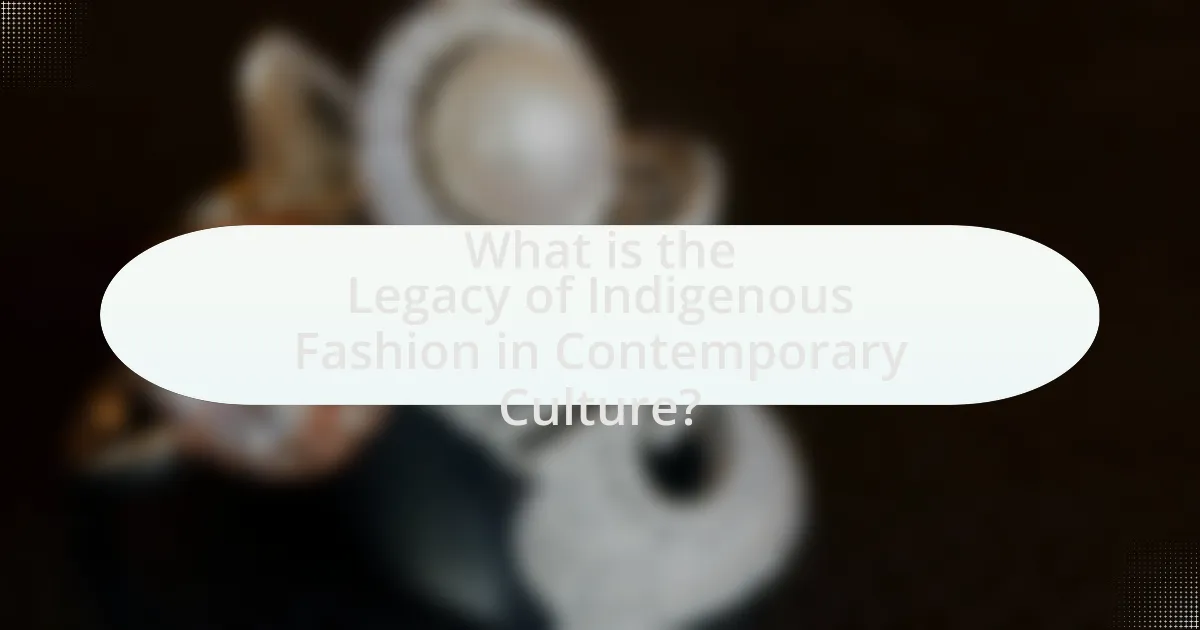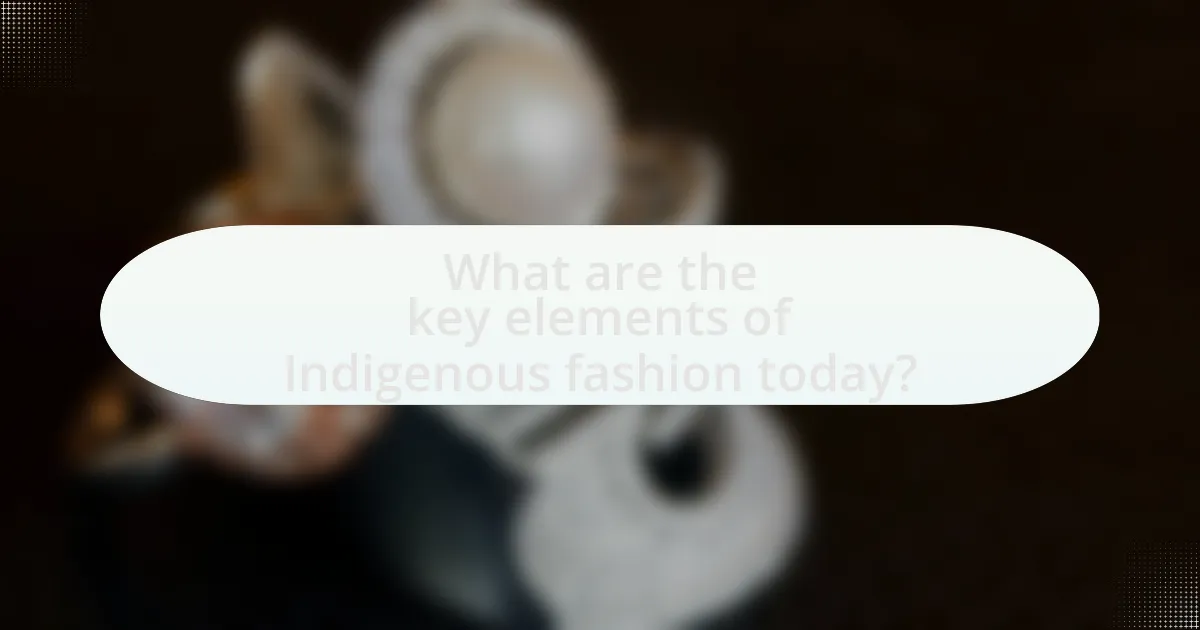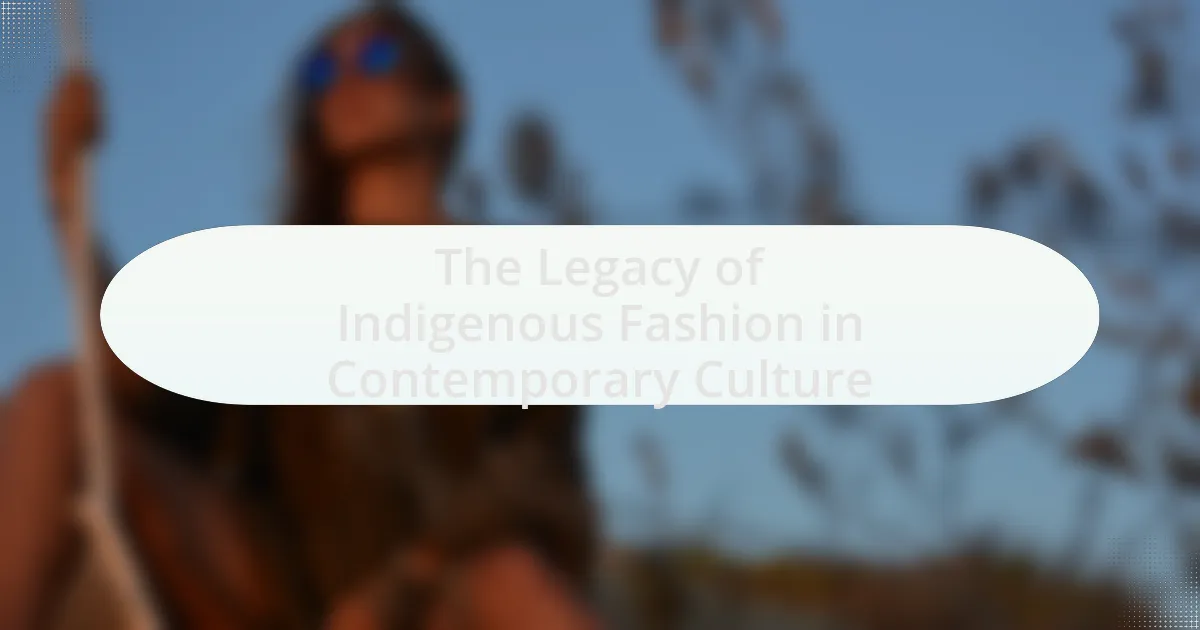The article explores the legacy of Indigenous fashion in contemporary culture, highlighting its resurgence and the recognition of Indigenous identities, aesthetics, and craftsmanship. It examines the evolution of Indigenous fashion from traditional garments to modern designs that incorporate cultural symbolism and sustainable practices. Key influences on Indigenous fashion, including historical adaptations and the impact of colonization, are discussed, along with the role of Indigenous designers in challenging mainstream fashion norms and addressing social issues. The article emphasizes the significance of Indigenous fashion in cultural identity, activism, and the promotion of ethical practices within the fashion industry.

What is the Legacy of Indigenous Fashion in Contemporary Culture?
The legacy of Indigenous fashion in contemporary culture is characterized by a resurgence and recognition of Indigenous identities, aesthetics, and craftsmanship. This revival is evident in the incorporation of traditional patterns, materials, and techniques into modern clothing, which serves to honor cultural heritage while also challenging mainstream fashion narratives. For instance, designers like Bethany Yellowtail and Virgil Ortiz blend contemporary styles with Indigenous motifs, showcasing the vibrancy and relevance of Indigenous cultures today. Furthermore, the global movement towards sustainable fashion aligns with Indigenous practices that emphasize environmental stewardship and community-based production, reinforcing the importance of these traditions in addressing contemporary issues.
How has Indigenous fashion evolved over time?
Indigenous fashion has evolved significantly over time, transitioning from traditional garments made from natural materials to contemporary designs that incorporate modern aesthetics and techniques. Historically, Indigenous fashion was deeply rooted in cultural identity, utilizing materials like animal hides, feathers, and plant fibers, which were crafted into clothing that reflected the wearer’s community and status. In the late 20th century, Indigenous designers began to gain recognition, blending traditional motifs with contemporary styles, as seen in the works of designers like Patricia Michaels and Bethany Yellowtail. This evolution reflects a broader movement towards cultural revitalization and self-expression, as Indigenous fashion now serves as a platform for addressing social issues and asserting identity in a globalized world. The rise of Indigenous fashion weeks and collaborations with mainstream brands further illustrates this transformation, showcasing the dynamic interplay between heritage and modernity.
What historical influences shaped Indigenous fashion?
Historical influences that shaped Indigenous fashion include the adaptation to local environments, the impact of colonization, and the integration of trade materials. Indigenous peoples developed clothing styles that utilized available natural resources, such as animal hides and plant fibers, to create functional garments suited to their climates. The arrival of European settlers introduced new materials like cotton and wool, which Indigenous communities incorporated into their traditional designs. Additionally, colonization led to cultural exchanges and the imposition of Western fashion norms, which influenced Indigenous aesthetics and practices. These historical factors collectively contributed to the evolution of Indigenous fashion, reflecting both resilience and adaptation in the face of changing circumstances.
How do traditional techniques manifest in modern designs?
Traditional techniques manifest in modern designs through the incorporation of indigenous craftsmanship, patterns, and materials that reflect cultural heritage. For example, contemporary fashion designers often utilize traditional weaving methods, such as those seen in Navajo textiles or Peruvian alpaca garments, to create modern apparel that honors ancestral skills. This blending of old and new not only preserves these techniques but also elevates them within the global fashion narrative, as seen in collections by designers like Aurora James, who integrates African textile traditions into her work. Such practices highlight the ongoing relevance of indigenous artistry in shaping contemporary aesthetics and promote cultural appreciation and sustainability in the fashion industry.
Why is Indigenous fashion significant in today’s society?
Indigenous fashion is significant in today’s society because it serves as a vital expression of cultural identity and heritage. This fashion movement not only preserves traditional techniques and materials but also challenges mainstream fashion narratives by promoting sustainability and ethical practices. For instance, Indigenous designers often utilize locally sourced materials and traditional craftsmanship, which contrasts with fast fashion’s environmental impact. Furthermore, Indigenous fashion has gained visibility through platforms like New York Fashion Week, where designers such as Bethany Yellowtail showcase their work, highlighting the importance of representation and storytelling in the industry. This visibility fosters greater awareness and appreciation of Indigenous cultures, making Indigenous fashion a crucial element in contemporary cultural discourse.
What role does Indigenous fashion play in cultural identity?
Indigenous fashion plays a crucial role in cultural identity by serving as a medium for expressing heritage, traditions, and community values. It reflects the unique histories and narratives of Indigenous peoples, often incorporating traditional techniques, materials, and symbols that are significant to their cultural practices. For instance, garments made from traditional textiles or adorned with culturally relevant motifs not only showcase artistic expression but also reinforce a sense of belonging and continuity within Indigenous communities. This connection to cultural identity is supported by studies indicating that fashion can be a powerful tool for cultural revitalization and resistance against assimilation, as seen in movements that promote Indigenous designers and their work in contemporary fashion contexts.
How does Indigenous fashion challenge mainstream fashion norms?
Indigenous fashion challenges mainstream fashion norms by prioritizing cultural heritage, sustainability, and authenticity over commercial trends. This approach emphasizes traditional craftsmanship and storytelling, which contrasts with the often fast-paced and profit-driven nature of mainstream fashion. For instance, Indigenous designers like Bethany Yellowtail and Virgil Ortiz incorporate ancestral techniques and materials, showcasing their cultural narratives and resisting appropriation. This commitment to cultural integrity not only redefines beauty standards but also promotes ethical practices, as seen in the growing movement towards sustainable fashion within Indigenous communities.

What are the key elements of Indigenous fashion today?
The key elements of Indigenous fashion today include the use of traditional materials, incorporation of cultural symbolism, and a focus on sustainability. Traditional materials such as animal hides, feathers, and natural dyes are often utilized, reflecting the heritage and practices of Indigenous communities. Cultural symbolism is prominently featured in designs, with patterns and motifs that convey stories, beliefs, and connections to the land. Additionally, sustainability is a crucial aspect, as many Indigenous designers prioritize eco-friendly practices and ethical sourcing, aligning with the values of their communities and the environment. This approach not only preserves cultural identity but also addresses contemporary issues in the fashion industry, such as environmental impact and cultural appropriation.
What materials are commonly used in contemporary Indigenous fashion?
Contemporary Indigenous fashion commonly utilizes materials such as natural fibers, leather, and beads. Natural fibers like cotton and wool are often used for textiles, while leather is sourced from animals traditionally hunted by Indigenous peoples. Beads, often made from glass or stone, are frequently incorporated into designs, reflecting cultural significance and craftsmanship. These materials not only serve functional purposes but also embody the cultural heritage and identity of Indigenous communities, showcasing traditional techniques and contemporary aesthetics.
How do natural materials reflect Indigenous values?
Natural materials reflect Indigenous values by embodying a deep connection to the land and the principles of sustainability and respect for nature. Indigenous cultures often utilize materials such as animal hides, plant fibers, and natural dyes, which are sourced in a way that honors the environment and maintains ecological balance. For example, the use of deer hide in traditional clothing not only showcases craftsmanship but also signifies a relationship of reciprocity with the animal and the ecosystem. This practice aligns with Indigenous philosophies that emphasize stewardship of the land and the importance of preserving natural resources for future generations.
What innovations are being introduced in material use?
Innovations in material use within the context of Indigenous fashion include the integration of sustainable materials, such as organic cotton and recycled fibers, alongside traditional materials like wool and leather. These advancements aim to enhance environmental sustainability while preserving cultural heritage. For instance, designers are increasingly utilizing plant-based dyes and natural fibers sourced from Indigenous lands, which not only reduces environmental impact but also supports local economies and traditional practices. This approach is validated by the growing trend of eco-conscious fashion, which emphasizes the importance of sustainability in material selection, as highlighted in studies on sustainable fashion practices.
How do Indigenous designers influence contemporary fashion trends?
Indigenous designers influence contemporary fashion trends by integrating traditional cultural elements, sustainable practices, and storytelling into their designs. This approach not only revives and preserves Indigenous heritage but also challenges mainstream fashion norms. For instance, designers like Bethany Yellowtail and Virgil Ortiz incorporate Indigenous motifs and techniques, which resonate with a growing consumer demand for authenticity and ethical fashion. The impact is evident as major fashion brands increasingly collaborate with Indigenous artists, reflecting a shift towards inclusivity and respect for cultural narratives in the fashion industry.
What are some notable Indigenous fashion designers and their contributions?
Notable Indigenous fashion designers include Bethany Yellowtail, who blends traditional Native American aesthetics with contemporary fashion, and her work emphasizes cultural storytelling through clothing. Another prominent designer is Virgil Ortiz, known for his innovative use of Pueblo pottery designs in high fashion, which bridges traditional art forms with modern design. Additionally, Jamie Okuma incorporates beadwork and traditional techniques into her garments, showcasing Indigenous craftsmanship on global platforms. These designers contribute to the visibility and appreciation of Indigenous cultures in the fashion industry, challenging stereotypes and promoting cultural heritage through their unique creations.
How do collaborations between Indigenous and non-Indigenous designers impact the industry?
Collaborations between Indigenous and non-Indigenous designers significantly enhance the fashion industry by fostering cultural exchange and promoting inclusivity. These partnerships often lead to the incorporation of Indigenous aesthetics and traditional techniques into mainstream fashion, which not only elevates Indigenous voices but also educates broader audiences about Indigenous cultures. For instance, the collaboration between Indigenous designer Bethany Yellowtail and non-Indigenous brands has resulted in collections that celebrate Native American heritage while reaching wider markets, thereby increasing visibility and appreciation for Indigenous artistry. This impact is evidenced by the growing trend of brands seeking authentic Indigenous collaborations, which has been documented in studies highlighting the economic benefits and cultural enrichment that arise from such partnerships.

How does Indigenous fashion intersect with social issues?
Indigenous fashion intersects with social issues by serving as a medium for cultural expression, identity affirmation, and activism against colonialism and systemic discrimination. This intersection is evident in the way Indigenous designers incorporate traditional techniques and materials into contemporary fashion, which not only preserves cultural heritage but also challenges stereotypes and promotes social justice. For instance, the work of designers like Bethany Yellowtail highlights issues such as land rights and environmental sustainability, using fashion as a platform to raise awareness and advocate for Indigenous rights. Additionally, Indigenous fashion often addresses the impacts of cultural appropriation, emphasizing the importance of respecting Indigenous intellectual property and promoting ethical practices within the fashion industry.
What role does Indigenous fashion play in activism?
Indigenous fashion plays a crucial role in activism by serving as a medium for cultural expression and political statement. It empowers Indigenous communities to reclaim their identities and challenge stereotypes through the use of traditional materials, techniques, and designs. For instance, the use of Indigenous motifs in contemporary clothing not only honors ancestral heritage but also raises awareness about issues such as land rights, environmental protection, and social justice. This is evident in movements like the “Idle No More,” where fashion became a tool for protest, showcasing Indigenous and solidarity. By integrating cultural narratives into fashion, Indigenous designers and activists effectively communicate their messages and foster a greater understanding of their struggles within broader societal contexts.
How do fashion shows and events promote Indigenous rights?
Fashion shows and events promote Indigenous rights by providing a platform for Indigenous designers and artists to showcase their cultural heritage and narratives. These events often highlight traditional craftsmanship and contemporary interpretations of Indigenous art, fostering greater awareness and appreciation of Indigenous cultures among diverse audiences. For instance, events like the Indigenous Fashion Week in Toronto have successfully elevated Indigenous voices in the fashion industry, leading to increased visibility and support for Indigenous rights and issues. By integrating Indigenous themes and perspectives into mainstream fashion, these shows challenge stereotypes and advocate for social justice, thereby contributing to the broader movement for Indigenous rights.
What messages are conveyed through Indigenous fashion statements?
Indigenous fashion statements convey messages of cultural identity, resilience, and social justice. These fashion choices often incorporate traditional designs, materials, and techniques that reflect the heritage and history of Indigenous peoples. For instance, garments featuring specific patterns or symbols can signify tribal affiliation and cultural narratives, while contemporary adaptations may challenge stereotypes and promote visibility for Indigenous communities. The use of fashion as a medium for activism highlights issues such as land rights and cultural appropriation, demonstrating how Indigenous designers and wearers assert their presence and voice in a broader societal context.
How can consumers support Indigenous fashion?
Consumers can support Indigenous fashion by purchasing directly from Indigenous designers and brands. This practice not only provides financial support to Indigenous communities but also helps preserve cultural heritage and traditional craftsmanship. According to a report by the National Indigenous Fashion Council, buying from Indigenous-owned businesses contributes to economic empowerment and sustainability within these communities. Additionally, consumers can promote Indigenous fashion through social media, raising awareness and appreciation for the unique cultural narratives embedded in these designs.
What are the best practices for purchasing Indigenous fashion ethically?
To purchase Indigenous fashion ethically, consumers should prioritize buying directly from Indigenous designers or brands that are owned and operated by Indigenous peoples. This practice ensures that profits support the communities and artisans involved, fostering economic empowerment. Additionally, consumers should seek transparency regarding the sourcing of materials and the production process, confirming that they align with Indigenous values and practices. Engaging with the stories behind the garments and understanding their cultural significance further enhances ethical purchasing. Research indicates that supporting Indigenous fashion contributes to cultural preservation and revitalization, as highlighted in studies by the National Indigenous Fashion Council, which emphasize the importance of ethical engagement in the fashion industry.
How can awareness of Indigenous fashion contribute to cultural appreciation?
Awareness of Indigenous fashion can significantly contribute to cultural appreciation by fostering understanding and respect for the diverse traditions and histories of Indigenous peoples. This awareness highlights the unique craftsmanship, symbolism, and narratives embedded in Indigenous garments, which often reflect the cultural identity and values of specific communities. For instance, the use of traditional materials and techniques in Indigenous fashion not only preserves cultural heritage but also educates the broader public about the significance of these practices. By engaging with Indigenous fashion, individuals can gain insights into the social and historical contexts that shape these artistic expressions, thereby promoting a deeper appreciation for Indigenous cultures.

Leave a Reply